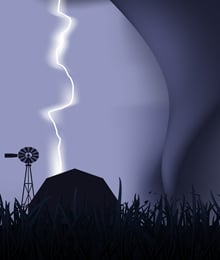
While the greatest number of tornadoes occurs in April, May, and June, tornadoes can occur at any time of the year, day or night. Fortunately everybody has the chance to survive a tornado. The keys to survival are preparedness and action. If you and your family are prepared ahead of time, you’ll be able to take the necessary action steps to survive a tornado and its aftermath. Here are some tips and resources to help prepare you and your family for a tornado and keep you all safe.
While we rely heavily on technology and weather alerts today, there are some signs that Mother Nature provides before a tornado. They are:
1. Green sky/clouds;
2. Hail;
3. Flying debris;
4. Low-lying cloud with a rotation;
5. Stillness and quiet; and
6. The sound of a freight train coming toward your neighborhood.
Tornado safety tips before the storm
1. Be prepared. Tornadoes can strike at any time, 365 days a year, with or without warning. Make sure your family knows your plan of action if a tornado warning is issued for your community. Some things to consider include discussing the best place to take shelter in your home, the difference between watches and warnings, the county you reside in, steps you will take during and after the storm, and creating a safety kit.
2. Practice, practice, practice. Being prepared for a tornado is just the first step in keeping your family safe. If you don’t practice the steps you put in place, panic and injury could occur.
Throughout the year, we have several practice drills at West Bend. We practice for fires, severe weather, and other life-threatening events. Our event disaster team does a good job of changing up the situation to make us think about what we’re doing. Take the opportunity to practice with your family. If you know your child’s school is conducting a tornado drill, take the opportunity that same day to practice at home. Also, ask your family questions about your plan and different aspects of a tornado, such as the signs of severe weather and where to take shelter.
3. Protect important information. Consider storing important information in your safe, storm shelter, safety deposit box at your local bank, or electronically. Important information could include your insurance policy, loan/mortgage papers, medical information (i.e., allergies, regular medications, or a brief medical history), important telephone numbers, a personal home inventory, birth certificates, and social security cards.
To learn about the importance of taking a home inventory, click here.
Tornado safety tips during the storm
1. If your home has a basement, seek shelter there immediately. If there’s a sturdy object in your basement, like a workbench or pool table, crawl under it to protect yourself from falling objects. If your basement has windows like mine, consider a place away from the windows. The safest spot in my basement is in the baby doll closet under the stairs. And yes, there are a lot of baby dolls in this closet.
2. If your home doesn’t have a basement, seek shelter immediately in an interior room like a closet or bathroom.
3. If you live in a mobile home or are camping in a camper, consider finding a designated safety shelter.
4. If you’re driving, seek shelter immediately or drive away from the tornado at a right 90-degree angle because tornadoes usually travel from west to east. Also, parking under an overpass will not protect you from a tornado. We’ve all seen pictures and TV footage where vehicles, including semi-trucks, are thrown around like toys. Find a ditch, culvert, or other low-lying area and cover your head. Be cautious of water flow if lying in a ditch or culvert.
5. If you’re watching your children performing at a concert in a school auditorium or watching them participate in their favorite sport in a school gym, be aware of your surroundings and identify a safe area where you could seek shelter. As we saw in the Moore, Oklahoma tornado, buildings with large roofs are dangerous and can be destroyed easily.
6. If you live in a dormitory or apartment building, find safety at the lowest place you have access and the most interior part of the building. Use stairwells to get there and, like fires, avoid using the elevator.
Tornado safety tips after the storm
1. If you’re away from your home at the time of the tornado, try to return safely. Listen to news reports to see if you can get up-to-date information about your neighborhood. Watch for fallen debris and power lines, and heed the advice of local authorities.
2. If your home has been damaged, consider turning off your main utilities, including your natural gas, electricity, and water main. If you smell natural gas, do not enter your home and call 911. To make your water main easy to find, consider attaching a West Bend tag. Click here to place your order.
3. Only consume food or water that was not damaged by the storm.
4. If your home has minimal water damage, consider cleaning the area with bleach. Make sure you wear rubber boats, gloves, and eye protection. The area should be properly ventilated so open windows and use fans.
5. If you lost power, protect yourself from carbon monoxide poisoning by using generators, grills, and other fuel-burning devices in a well-ventilated area.
6. If your home was not damaged, contact your friends, family, and neighbors to make sure they’re safe. Ask them if they need a safe place to stay.
7. If possible, review your insurance policy and follow the necessary steps to contact them and file a claim.
Do you have any tips or information you’d like to share? I’d love to hear them; please share them in the box below.





